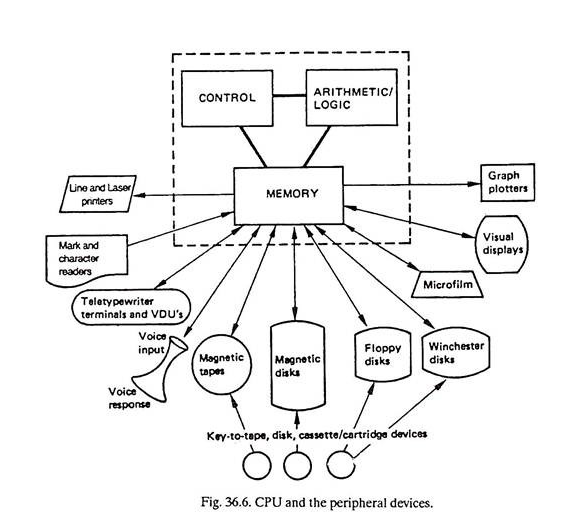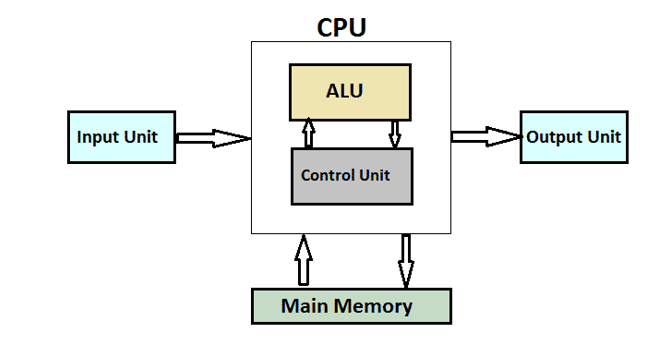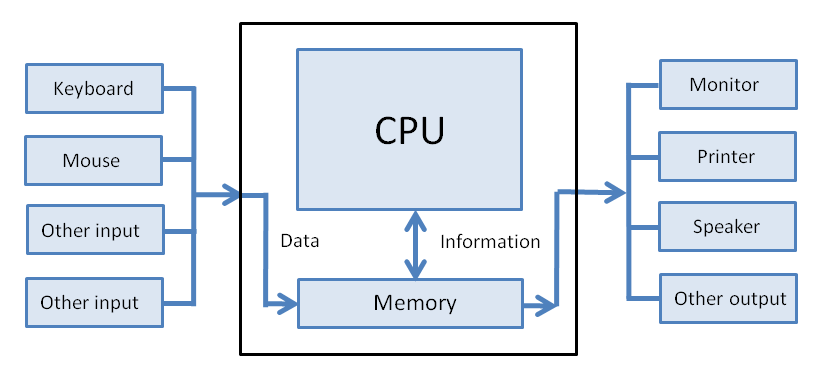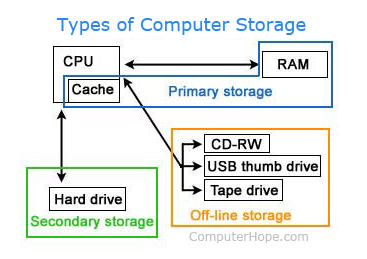Join Our Groups
TOPIC 2: THE COMPUTER
Significance of Computer
The Computer
Define a computer
A computer can be defined in several ways but the best definition of a computer should contain main terms like INPUT, PROCESS, STORAGE and OUTPUT.
The following are various definitions of the computer
A Computer is:
- An electronic machine that processes raw data to produce information
- Is an electronic device that receives or accept input[data] processes it and then produces output or information
- Is a machine programmed to accept data process it into useful information [output]
- Is an electronic devices that works under the control of stored program, automatically accepting and processing data to produce information.
- Is an electronic machine that accept data from an input device performs arithmetic and logical operation according to predefined programs and finally transfer the processed data to any output devices.
Input is the unprocessed data which enters the computer.
Output is the processed data from computer.
Storage the computer holds data internally during and after processing.
Processing this is the process of converting input(data) into output (information).
Summarizing the basic function of computer we have:

Characteristics of computer
- Speed: computer works in speed.
- Accuracy: computer never makes errors..Errors are made by human being who use the computer.
- Storage: computer has memory for keeping data.
- Versatility:a computer can perform job logically and step by step.
The need for the computer
Explain the need for the computer
Computer has many applications in real life.
COMPUTERS IN EDUCATION
- Gathering information from internet.
- Developing science projects.
- Teaching projects and learning process.
COMPUTER IN HEALTH
- In health computer can be used for Diagnosing illness.
- Modifying parent health development.
- Assisting surgeons.
COMPUTERS AT HOME
- Writing letters.
- Listening music
- Playing games
- Watching movie
COMPUTERS IN LAW ENFORCEMENT
- Store information.
- Making documents and printing documents.
- DNA and finger printing.
COMPUTERS IN MUSIC INDUSTRY
- Composing music.
- Editing sound
- Editing videos
COMPUTERS IN TRANSPORTATION
- It can be used for traffic control
- It can be used in driving stimulator
- It can be used for reservation systems
- Computers are embedded in air craft to provide efficiency in flying
COMPUTERS IN GOVERNMENT
- It can be used for internal revenue service's i.e. to provide reports for tax purposes.
- It can be used for planning, analysis, forecast, sampling, predictions etc.
- It can be used for weather forecasting.
- It can be used for law enforcement.
COMPUTERS IN MILITARY
- It can be used for planning and decision making.
- It can be used by planners to stimulate wars.
- It can be used to guide modern weapons such as missals and field artillery
COMPUTERS IN BANKING AND BUSINESS
- To allow banks clerks and customers to find out bank balance in an account.
- To help bank clerks to record money paid in and out.
- To check computer sensitive cheques.
- To do reservation system for air line travel by checking if there is free seat on a flight.
- To help retailers to check out stock at a super market.
- To allow people to use Automatic Teller Machine in cash withdrawal and transfer funds between accounts.
- To keep track of current prices of market stocks , bonds and currency.
- To create an effective way of producing document example reports, brochures, cards etc.
COMPUTERS IN INDUSTRY AND ENGINEERING
- To design drawing for products using computer aided design (CAD) programs example airplanes , bridges, buildings etc
- To manufacture products using computer aided manufacturing (CAM)
- To plan and control major projects.
- To stimulate or predict what will happen in real life situations from a model situation example turning on/off traffic lights
- To control some operations in automobiles example mixing of fuel and air entering the engine.
- A new technology called artificial intelligence can solve problems in areas like medicine ,law etc.
Hardware
Hardware is a collection of physical components which form a complete computer system OR Hardware is the actual machinery that makes up the computer system OR Hardware is the set of all physical parts of the computer.
Different parts of a computer
Identify different parts of a computer
TYPES OF COMPUTER HARDWARE
The computer hardware is composed of the following elements:
- Input devices OR Input Hardware example keyboard, scanner, touch screen, joystick, mouse.
- Central Processing unit (CPU) OR Processing Hardware example control units, main memory.
- Output Devices OR Output Hardware example printers, monitor, plotter, speakers
- Secondary Storage Devices OR Storage Hardware example Hard disk, floppy disk, CD, RAM, DVD
- Communication devices OR Communication Hardware example modem, CRT, terminals.
PERIPHERAL DEVICES / HARDWARE
- A peripheral device is a device that located outside the CPU but controlled by it.
- It is an attachment to a computer used to feed unprocessed data into the computer and receive the output of processed information.
CATEGORIES OF PERIPHERALS
- Input devices
- Output devices
- Input/output devices
- Storage devices
- Communication devices
A DIAGRAM SHOWING PERIPHERAL DEVICES

The computer block diagram
Draw a computer block diagram
COMPUTER BLOCK DIAGRAM

Input Devices
An input is a means to get data into a computer system OR input is the data that is put in the computer system for processing
Common computer input devices
List common computer input devices
TYPES OF INPUT
- DATA : the row facts
- PROGRAMS: a series of instructions that tells the computer how to perform tasks
- COMMANDS: These are instructions given to a computer program
- USER RESPONSE: is an instruction you issue to the computer by replying to question posed by a computer program. example do you want to save?
The function of input devices
Explain the function of input devices
FUNCTIONS OF INPUT DEVICES
- To accept data from the user into the computer system
- To accept instructions from the users
- To accept commands for running or aborting/halting a program from the user.
Central Processing Unit
Central processing Unit
Explain central Processing Unit
The CPU is called the processor and it is basically the brain of the computer. CPU is the part of the computer system that follows the instructions to manipulate data into information.
Sections of CPU
Describe sections of CPU
COMPONENTS OF THE CPU
- The CPU has two main parts. these are:
- (i)The Arithmetic -logic unit (ALU): It performs mathematical operations ( +,-,x, )
- (ii)The Control Unit (CU)

BLOCK DIAGRAM OF THE CPU
The functions of different parts of CPU
List the functions of different parts of CPU
FUNCTIONS OF THE CPU
- To control the sequence of operations according to instructions
- To give commands to all other parts of the computer system.
- To carry out processing data into information.
- To send processed results to the output.
- To store data and all the instructions
Output Devices
Output devices
List output devices
Computer output devices are used to provide information for a user in different forms. The formats include visual, audio and digital. A CPU is responsible for processing the instructions and the devices are responsible in outputting the processed information in different formats depending on the type of output device we have.
When we talk about output devices, some of the devices in this group can do both the input and the output process. These kinds of devices enable us to provide information to it and receive information from it. Touch screen is an example of input/output device.
For example, Mobiles and touch monitors incorporate this technology. Here are the most common computer output devices.
Monitor
Computer monitor or screen is a device used to display information to a user. Whether you are playing a game or watching movies or doing other tasks, the result is shown on screen.
Speaker
- Computer speaker is the other output device which is used to hear a sound played by a computer. Speakers can be built in with the motherboard or comes as a separate part. It connects with the computer speaker with a cable.
- Unlike the old speaker’s types, modern speakers come with USB connection which does both functions – connection and power supply. The built in speakers can be heard through a headphone, if you don’t want to buy the independent speaker set.
- Headphone is also an output device used to hear music from digital portable players, such as MP3 players, IPods and stuff like that. It is designed to fit into an ear. It is also used mostly to play computer games and chat online.
Printer
- Printer enables us to get computer output on paper. It is one of the most popular computer output devices we often use to get information on paper - called hard copy.
The functions of output devices
Explain the functions of output devices
List of Output Devices and Their uses or Functions:
- Monitor (LED, LCD, CRT etc): A display is must need output device on a computer. It is used to display the data or information.
- Speaker(s): A speaker is used to output the audio from the computer.
- Plotters: Plotters is one kind of printer which is used to print vectors graphics. It uses a pen, pencil, marker, or another writing tool instead of toner.
- Projector: A projector is used to display the data or information on another screen rather than a monitor. It helps to perform the presentation perfectly.
- LCD Projection Panels: It works as like the projector. It is used to display the digital data, information or video into the bigger screen. You can call it the updated technology of the projector.
- Computer Output Microfilm (COM): Computer Output Microfilm is the invention to store the data. It converts the data from the computer into a microfilm. It is used in the archives.
- Printers (all types): Printers are the output equipment which helps to make the image, text or graphics into the human-readable form on paper
- Head Phone: Head Phone is the hearing devices which converts the digital signal into the human-readable format.
- Visual Display Unit: It helps to display the digital data, graphics or information. Simply, the monitor is used mostly to give the example of VDU. Though it is all type visual display devices including projector or LCD projection panels.
- Film Recorder: Film Recorder is the computer output devices which helps to convert the digital images into the photographic film.
- Microfiche: Microfiche is mainly used to reproduce the documents or data for storing or reading. It is used to make the archive, newspaper industry or library.
Connect output devices to the system unit
Connect output devices to the system unit
Example 1

Secondary Storage
Secondary storage devices
Define secondary storage devices
A storage medium is a physical material on which items (data, instructions and information) are kept for future uses
Examples of secondary storage devices are:
- Floppy disk, magnetic diskette
- Magnetic disk or hard disk
- Magnetic tape
- Optical disks like CD, CD-ROM, DVD. DVD-ROM. DVD-RAM ETC

CHARACTERISTICS OF SECONDARY STORAGE DEVICES
The following are the characteristics of secondary storage devices:
- They are less expensive
- They are not part of the CPU
- They have larger storage capacity
- They are non-volatile
- They are permanent
List of secondary storage devices
List secondary storage devices
Secondary Storage Devices are essential as the size of Primary storage or main memory in every computer is limited. With this, the computer can only accommodate a limited sized program and data. To carry out big jobs like commercial data processing, it becomes essential that data be held in some expansive form of storage. This is achieved through secondary storage Devices. It is also called as external storage, and can hold data either sequentially or at random. You should always keep in in mind that data in secondary storage devices is not directly accessible and has to be routed through the main storage for processing.
Types of Secondary storage Devices in Computers are:
- Magnetic tape
- Magnetic disk and
- Magnetic drum.
Magnetic tape:
Tapes are used for recording and storing data for computer processing. It is plastic reel similar to long lengths of movie film. A tape is usually ½” wide and 2400 feet in length and it is coated with particles of ferric oxide on which data can be recorded magnetically.
Magnetic disk:
- Magnetic disk is another type of secondary storage device known as random (direct) access as it permits direct accessing of data. An individual disk is a circular metal plate coated on both side by ferrous oxide material.
Magnetic drum:
- It is a metallic cylinder coated with a special magnetic alloy.
- Data is stored in this surface as minute magnetized spoke arranged in binary form in a series of parallel circular tracks.
- The drum rotates at a constant speed and data is recorded (or) retrieved by the read/write head. One for each track.
CD-ROM
CD-ROM (Compact Disc Read Only Memory) is a Compact Disc contains data accessible by a computer. While the Compact Disc format was originally designed for music storage and play back, the format was later adapted to hold any form of binary data.
HARD DISK
A hard disk drive [HDD], commonly referred to as a hard drive, hard disk or fixed disk drive. It is a non-volatile secondary storage device which stores digitally encoded data on rapidly rotating platters with magnetic surfaced.
FLOPPY DISKS
These are also called as flexible disks. These are used in the smallest micro computer systems as well as mini computers. Floppy disks have higher storage capacity and offer direct access capability. The floppy disk is permanently sealed in a plastic coated jacket and the whole package is inserted the floppy drive for data recording and retrieval.
Advantages and disadvantages of different secondary storage devices
State advantages and disadvantages of different secondary storage devices
Hard disk
| Advantages | Disadvantages |
| Hard drives have a read/write speed | Consumes a lot of power |
| Hard disks stores data without the need of a constant electricity supply | Data error is frequent |
| Hard disks allow data to be stored in one place | Can be broken if dropped |
| It is large |
Optical disk such as CD and DVD
| Advantages | Disadvantages |
|
|
- CD ROM/DVD ROM
- CD R/DVD R
- CD RW/DVD RW
- DVD RAM
- Blu-ray
Other optical disk
Portable hard disks
| Advantages | Disadvantages |
|
|
Magnetic tapes
| Advantages | Disadvantages |
|
|
Memory stick
| Advantages | Disadvantages |
|
|
Flash memory cards
| Advantages | Disadvanteges |
|
|
Differences between primary and secondary storage devices
Distinguish between primary and secondary storage devices
DIFFERENCE BETWEEN PRIMARY STORAGE AND SECONDARY STORAGE
| PRIMARY STORAGE | SECONDARY STORAGE |
| Primary memory storage is temporary | Secondary storage is permanent |
| Nature of parts of primary storage varies. RAM is volatile in nature and ROM is Non-volatile. | It is always Non-volatile in nature |
| Example RAM, ROM, Cache Memory and PROM | Example Magnetic tapes, Floppy disk, USB drivers and Optical disk |
| Primary memory is expensive and smaller | Secondary memory is cheaper and larger |
| Primary memory storage is faster | Secondary storage are slower. |
| Primary memory storage is connected through data buses to CPU | Secondary storage is connected through data cables to CPU |






EmoticonEmoticon